"Hey! Is that a film camera?"
"No, this one's digital, but I got a film camera in the bag," I reply. While tapping on the chrome top of my digital rangefinder, I added,
"I think people ask me if it's a film camera because it's so cute."
"No, it's because it looks like the camera my father used in the seventy's," he replied.
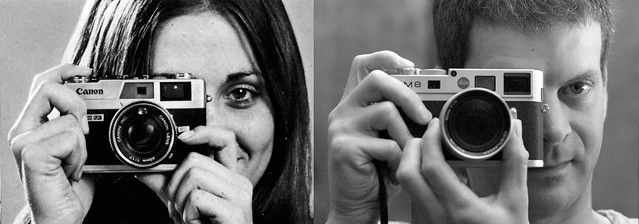
The camera your father used in the seventy's by nocklebeast.
The sort of camera your father (or was it your mother?) likely used in the 1970's was something called a rangefinder camera. The first rangefinders appeared early in the 20th century and were popular from the 1930's to the 1970's.
By the time the 1980's rolled around, your father was probably shooting with something called an SLR, a single lens reflex camera. Besides digital point-n-shoots and smart-phones, the (digital) SLR is the sort of camera you most often see at roller derby bouts. They're big. They have big lenses. And they're very professional looking. Lots of them have fancy features like auto-focus and image stabilization and what-not.
When a photographer looks through the viewfinder of an SLR, they see an image from the lens that is focused on a bit of ground glass. When the photo is taken, a mirror moves out of the way and the light is focused on the film or the digital sensor and an image is recorded. If the lens is a zoom lens or a telephoto lens, then the image the photographer sees in the viewfinder is magnified as well.
However, with a rangefinder, the lens doesn't magnify the image the photographer sees in the viewfinder at all. The viewfinder simply consists of a little glass window with some rectangular lines showing where the frame of the photo will approximately be. When the focus ring of the lens is manually turned, a little prism moves, which moves a secondary image in the viewfinder, sometimes known as a "focus patch." Let's consult the friendly manual from your father's seventy's rangefinder,
"While looking through the viewfinder, turn the focusing lever. The subject is in focus when the double image merges into one precise image in the center of the viewfinder." [emphasis added.]
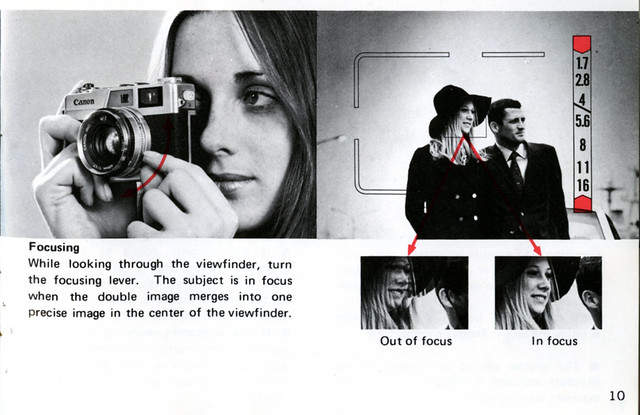
the subject is in focus when the double image merges into one precise image in the center of the viewfinder by nocklebeast
Let's take a closer look at what the view in the viewfinder of a modern rangefinder looks like.
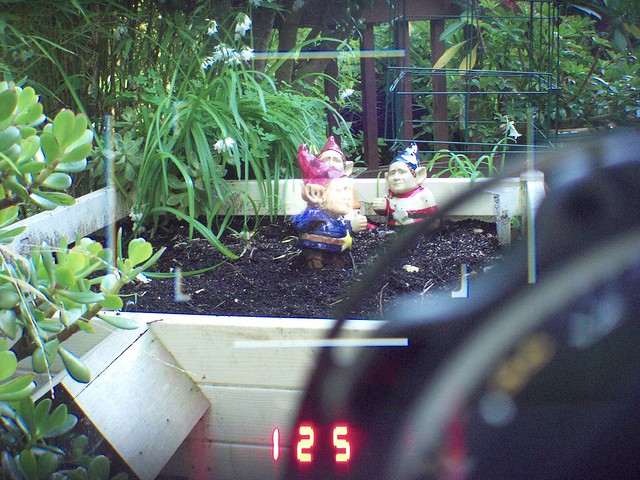
RF viewfinder by nocklebeast
Everything (subjects both near and far) in the viewfinder appears to be in perfect focus, just as if you were looking out of a window in your home. In the center of the frame, we see a double image of George the yard gnome. Just a small clockwise turn of the lens will move George's ear in the secondary image of the focus patch to line up with the primary image of his ear in the viewfinder. We also see two sets of rectangular frame lines, one for a 50mm lens and a smaller frame line for a 75mm lens. Of course, a photo taken with the longer focal length lens (75mm in this case) records an image that appears closer to the subject than with a lens with a smaller focal length (50mm), but the photographer's view in the viewfinder doesn't change with the focal length of the lens used. In addition to seeing what is inside the frame lines, the photographer also sees what lies outside of the frame lines. In this way, the photographer sees how a scene develops and can snap the photo when interesting subjects move into the frame from outside the frame. This is one of the primary differences between rangefinders and SLRs. One of the best webular articles about the differences between rangefinders and SLRs can be found here: http://photozone.de/slr-vs-rangefinder
Let's take a second look through the viewfinder of the rangefinder shall we?
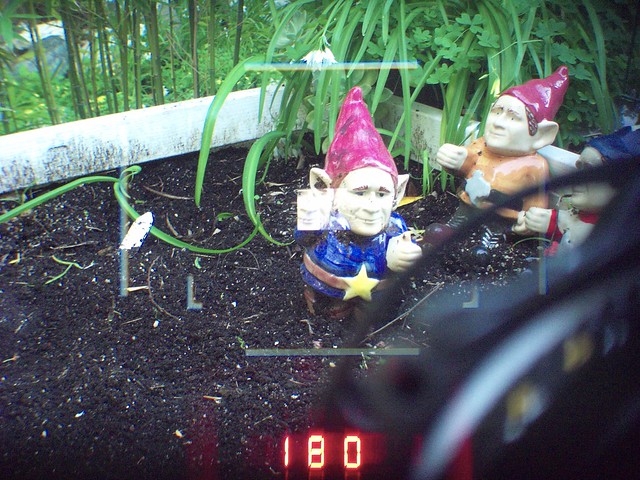
RF viewfinder by nocklebeast
In aperture-priority mode, we see the shutter speed that will be be used for the correct exposure in the lower part of the view (1/180th of a second). And we see the lens in the lower right hand corner in the viewfinder. This is something you would never see when using an SLR. The image seen in the viewfinder of an SLR originates from light entering the lens of the SLR. With a rangefinder however, if the lens is particularly long or wide the lens will partially block the view in the viewfinder. In the photo above we see the lens and lens hood of one of my favorite lenses, the fast Hexanon f1.2 60mm lens. Because the lens is so wide, it can collect lots of light in low light conditions, but that means it blocks some of the view in the viewfinder. In addition to that, it has a bit of an oddball focal length of 60mm. This doesn't correspond to either the 50mm or the 75mm frame lines, and so the photographer will need to imagine where the 60mm frame lines might lie between the 50mm and the 75mm frame lines.
When a normal or telephoto lens is used with a rangefinder (as opposed to a wide-angle lens), it is sometimes helpful to increase the magnification of the viewfinder by screwing on a little magnifying glass to the viewfinder as shown below (lower left).
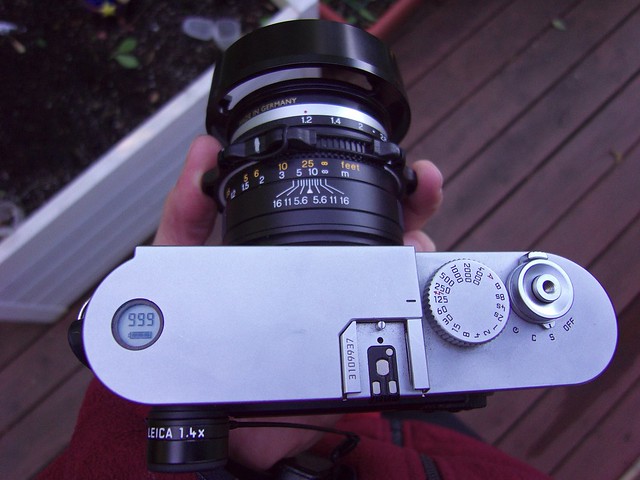
focus assist by nocklebeast
In this case, attaching a 1.4x magnifier to the viewfinder window gives a 0.95 magnification factor through the viewfinder. With the magnification factor so close to one, this allows the photographer to open they're left eye and see a view with their left eye with nearly the same magnification as the right eye looking through the viewfinder of the camera. In this way, the photographer can become even more aware of what subjects lie outside of the photo frame, but which may move into the photo frame at any given moment. (Maybe that's why all the photos of photographers in the friendly manual for the camera your father shot with in the 1970's have they're eyes open.)
I once remarked to Sharkey at the 2009 WFTDA Western Regional roller derby tournament that viewing a roller derby bout behind a viewfinder is a different way of seeing the bout. He agreed, replying that he could see the expression on the roller girls' faces as they're skating towards him. I thought to myself, "oh. I don't see that so much. I guess SLRs really are different than rangefinders." Sharkey was referring to the fact that his view in the viewfinder is magnified, and so he can see expressions close up, that aren't as readily seen by someone merely close to the action. I see the expressions everyone else sees (normal view, not telephoto).
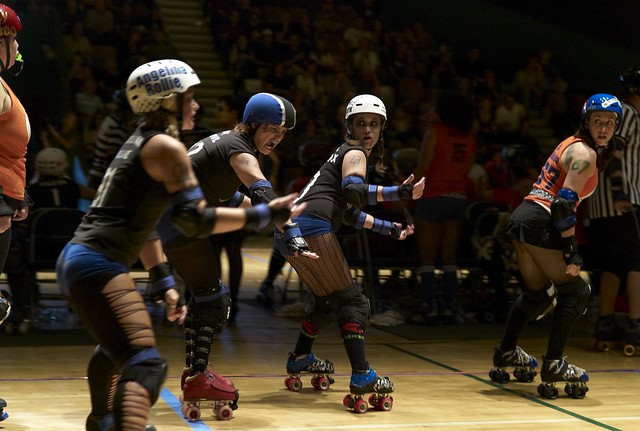
Pixie yells by nocklebeast
I suppose what I really meant was that seeing the bout behind a viewfinder of a camera is a different way of paying attention to a bout.
Many digital SLRs have some sort of auto focus. Dynamic 50-point, phase contrast, infrared laser assist, auto focus. I'm not really sure what any of that means. My idea of focus assist is to glue on a little plastic knobby ring onto the manual focus ring of the lens. The knobs allow me to find the focus ring on the lens quickly by feel.

focus assist by nocklebeast
Many SLRs since the 1980's have an auto-exposure program called shutter-speed priority. The photographer sets the shutter speed to a fixed value, and the camera's light meter determines the aperture of the lens depending on the light of in the scene. This feature comes in handy for fast moving subjects such as sports. A fast shutter speed is selected to "freeze" the action. But some rangefinders have shutter-speed priority as well. If, in the 1970's, your father used a Canonet QL17, shutter-speed priority was described as "automatic electric eye photography" in the friendly manual.
 automatic electric eye photography by nocklebeast
automatic electric eye photography by nocklebeastMy rangefinder has an aperture-priority auto-exposure program. (This feature is common to SLRs as well.) The aperture is set manually and the light meter in the camera chooses an appropriate shutter speed depending on how the scene is lit.
I once compared notes with another photographer at a roller derby bout in San Francisco. I was trying to explain an exposure scheme I came up with which I thought was really clever. I set the shutter speed to 1/125th of a second, which is maybe just barely fast enough to freeze the action. And I'll pretty much leave it at that shutter speed for the entire bout. I'll manually adjust the aperture in the f1.2 to f2.8 range, and I'll set the ISO to auto-ISO. This way, depending on the aperture and shutter speed and how the scene is lit, the light meter of the camera will set the "film sensitivity" or ISO to get the correct exposure (in the range of 160 to 2500). It's sort of a pseudo-shutter speed priority. The other photographer looked at me, looked a the camera and said, "It has a lot of manual controls, then, huh?" "Um... yeah," I replied.
rangefinders don't do sports
The conventional wisdom is SLRs are better suited to sports photography than rangefinders. Frank Van Riper in a recent "Talking photography" article (in which he compares Leica's latest rangefinder to, of all things, an iPad) says, "Leica rangefinders don't do sports, but they are great for most everything else."
But, I wonder. Is it the wrong camera? Or the wrong sport? Maybe, photographers should be taking their rangefinders to, yeah, you guessed it, roller derby!

vampires suck by nocklebeast
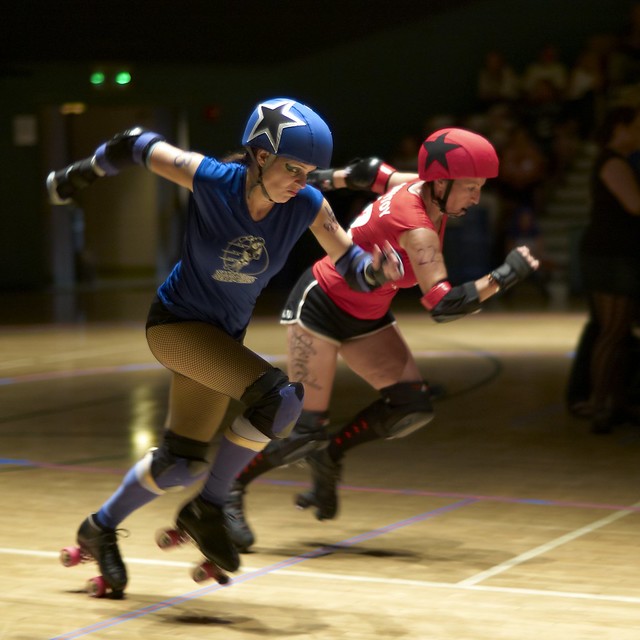
Sheila vs Tonka by nocklebeast
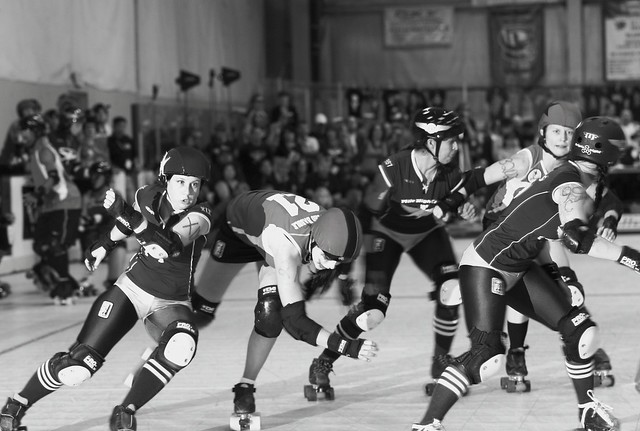
flashed by nocklebeast
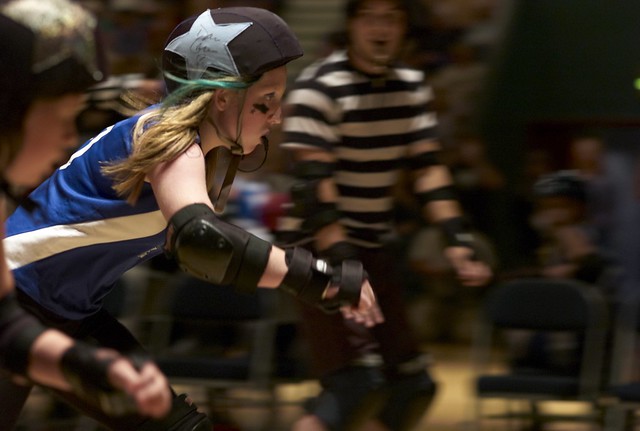
Slambi is wearing the lucky Dan Green star by nocklebeast

just a little practicin' before the big bout by nocklebeast
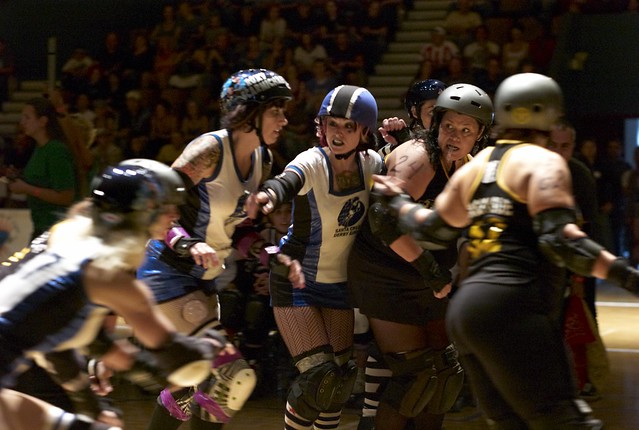
a little crazy look by nocklebeast

calling off the jam by nocklebeast
Sometimes, a shutter speed of 1/125th of a second isn't quite fast enough to freeze the action.
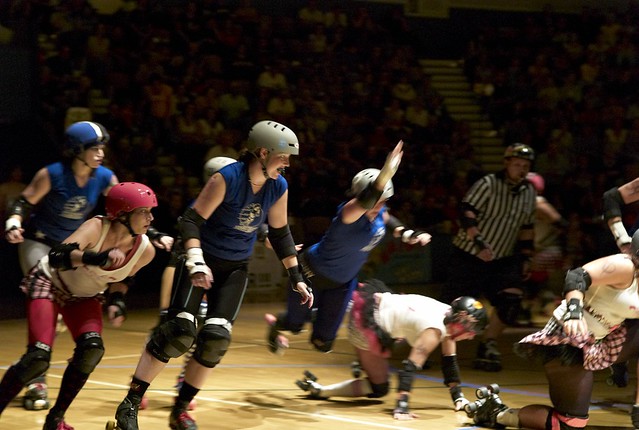 ohmagawd! Shammy! by nocklebeast
ohmagawd! Shammy! by nocklebeastHow do you catch the action with a manual focus lens? One approach is to prefocus the lens to a certain distance, and wait until the roller girls skate into focus. Now the rules of roller derby require that helmet cover colors must meet a definition of high contrast beyond a reasonable doubt. Which may explain why sometimes I find the jammer's star to be in the place of most precise focus in the dead center of the frame (where the rangefinder's focus patch is).
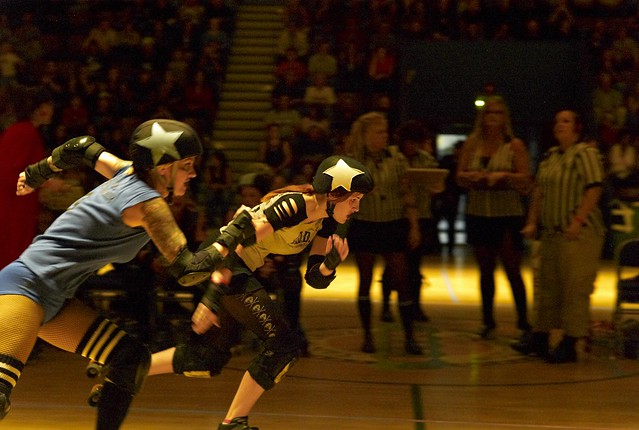 sprinting by nocklebeast
sprinting by nocklebeastAlthough if the skaters skate slow enough I can keep up with them with my manual focus ring.
What did photographer's do before SLRs were invented? One of the most astonishing photographs (and it's much better as a 10x14 inch reproduction, instead of this 3x5 inch reproduction on the web) is Alexander Rodchenko's Horse Race.
 |
| Horse Race by Alexander Rodchenko |
 |
Kinda puts sitting in the suicide zone during a grom bout in perspective.
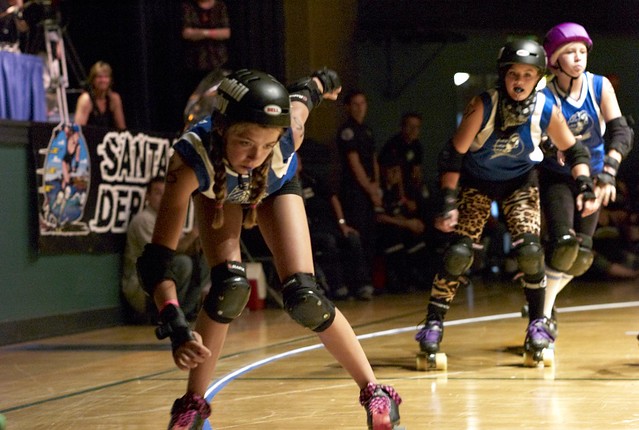 oh, this is a little close by nocklebeast
oh, this is a little close by nocklebeastSometimes, if you are not that close to the action, you just put on a really long lens on the camera and aim. In this case we get a nice "Mystery Science Theater 3000" effect, shooting from the stands shooting with a 135mm lens. I think Crow T Robot is somewhere in the suicide zone cheering on Bloody Mary of the Texas Texacutioners.
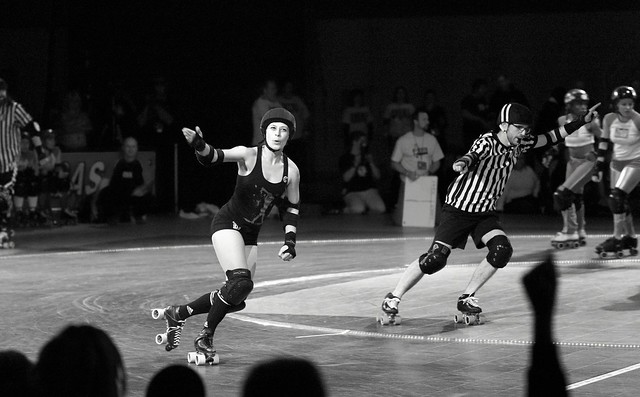 blowin' kisses to the crowd by nocklebeast
blowin' kisses to the crowd by nocklebeastSometimes, when I have a telephoto lens on the camera I'll find it a bit too long for the intended subject. With a fixed focal length lens you have to zoom with your feet. But what if there isn't room enough to walk back and fit the subject in the frame? That situation may require a bit of improvising.
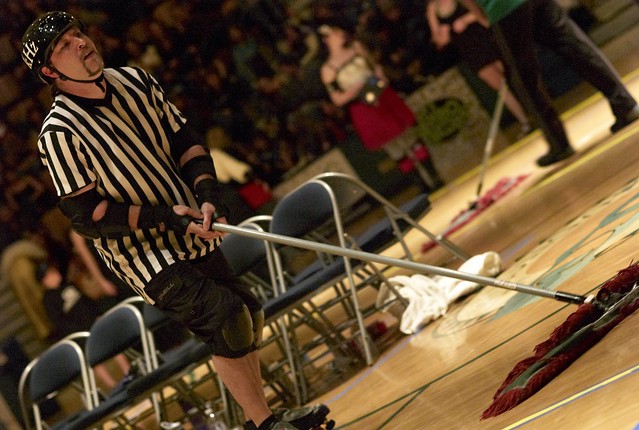 sometimes the blood is so thick on the track by nocklebeast
sometimes the blood is so thick on the track by nocklebeastJust turn the camera so the subject is within the framelines. Problem solved.
Now roller derby is a sport, but it isn't merely a sport. There's lots of stuff besides girls on skates to make photos of.
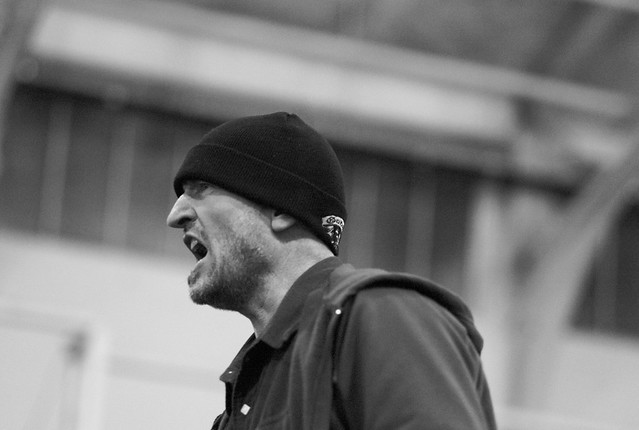 go Oakland! by nocklebeast
go Oakland! by nocklebeast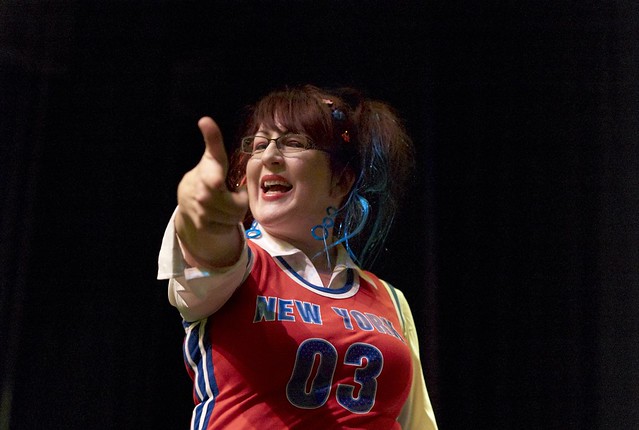 lookin' Fierce! by nocklebeast
lookin' Fierce! by nocklebeast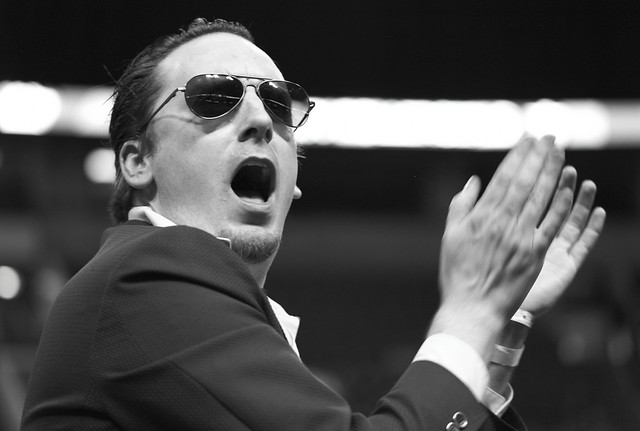 put your hands together Seattle by nocklebeast
put your hands together Seattle by nocklebeast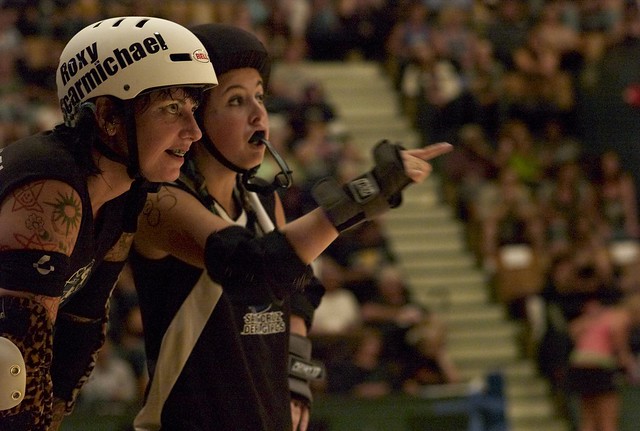 a penalty becomes a teachable moment for a young grom by nocklebeast
a penalty becomes a teachable moment for a young grom by nocklebeast 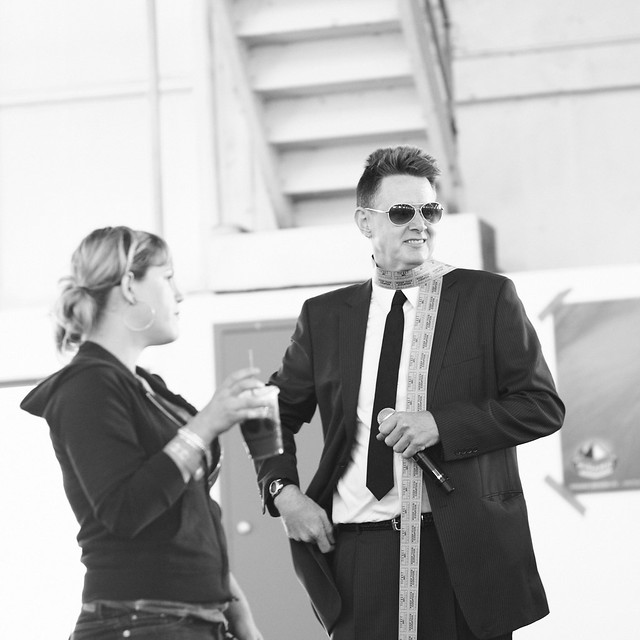 Sexay Beeeast! by nocklebeast
Sexay Beeeast! by nocklebeast
Miss Whoop D. Doo! by nocklebeast

cha-cha-cha! by nocklebeast
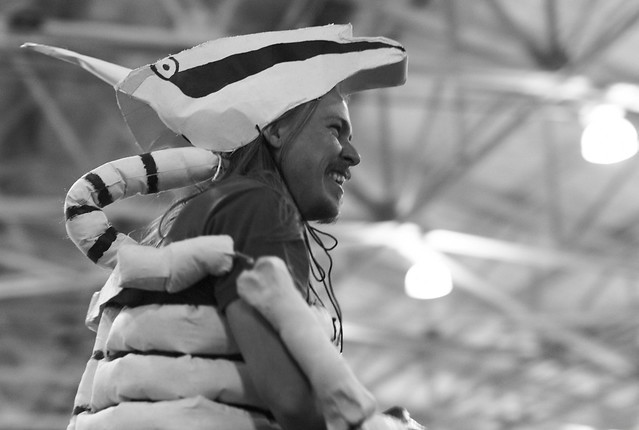 shevil dead skeleton man by nocklebeast
shevil dead skeleton man by nocklebeast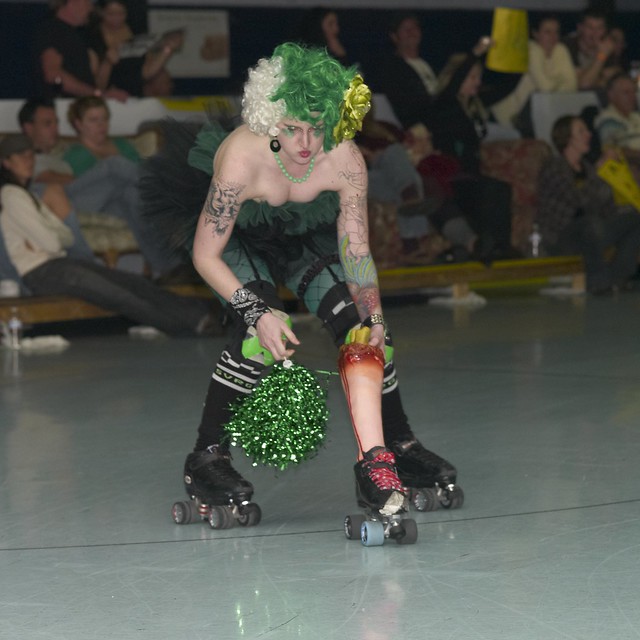 with a little encouragement and training that severed limb might just make the team by nocklebeast
with a little encouragement and training that severed limb might just make the team by nocklebeastAnd of course there are other photographers getting shots at roller derby bouts (there's lots of shots to get at roller derby bouts)
 ah! I hope he got that shot! by nocklebeast
ah! I hope he got that shot! by nocklebeastEven during halftime.
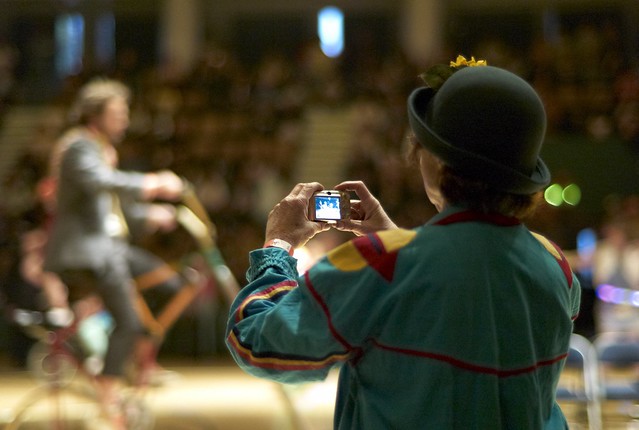 taking photos by nocklebeast
taking photos by nocklebeast




5 comments:
I suppose I should offer one small clarification about zoom lenses on rangefinders. In the last few days I've read a couple of interesting essays on what digital rangefinders are and what they could be (see pay site www.reidreviews.com and http://www.luminous-landscape.com/essays/leica-different-view.shtml). Mark Dubovoy points out that Leica used to produce a couple of M-mount zoom lenses for Leica rangefinders. And Camera Quest is currently selling an auxillary wide-angle zoom finder (albeit one that is not coupled with the focusing mechanism).
Perhaps, someday, there will be fully coupled zoom lenses and viewfinders on digital rangefinder cameras.
Great write up- I really enjoy the work you do and often refer to your photos as inspiration and tips for POV, lighting, framing etc. great work..
yeah, I know what you mean. I've also spent a lot of time studying derby photographs on the web.
I suppose the comment section is as good a place as any to point out interesting articles on rangefinder.....
Here's one written by someone named Egor... albeit in the context of the rangefinder's more traditional subject
http://www.ultrasomething.com/photography/2010/07/to-whom-it-may-concern/
who would win in a fight? SLR vs rangefinder
http://japancamerahunter.com/2012/08/why-rangefinders-by-anthony-chang/
Post a Comment